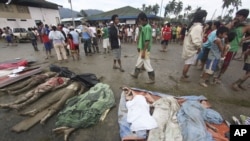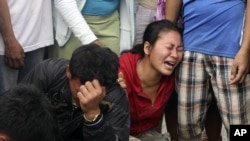MANILA —
The southern half of the Philippines is reeling from a major typhoon that has so far left more than 230 people dead. The state weather bureau says Typhoon Bopha is on a northwest path from the country’s western-most island province of Palawan.
Officials say they are now focused on rescue and relief efforts after Typhoon Bopha barreled through the southern Philippines Tuesday, packing winds that peaked at 210 kilometers per hour. The powerful gusts shattered homes to splinters, uprooted trees and blew down power lines and cell towers. Heavy rains caused waist-high flooding and multiple landslides.
The civil defense office says close to 100,000 people have been evacuated. Civil Defense Chief Benito Ramos says the military, national police and other agencies are still trying to get people to safety.
He says good weather Wednesday has allowed rescue workers to use the military’s limited number of helicopters. But Ramos says, in some cases, rescuers are resorting to traveling on foot because of the obliterated and mud-caked roads.
“If the roads and bridges are collapsed [and] the use of aircraft is not feasible, then we use the Army personnel to bring in food and non-food items to devastated areas, especially those areas that are far-flung,” he said.
Ramos says most of the deaths have been reported in the Compostela Valley on the eastern edge of Mindanao, the country’s largest island in the south. Numerous landslides buried people and covered entire towns in mud.
Ramos says Davao Oriental, next to the Valley, and along the east coast was also particularly hard hit. Nearby Surigao del Sur province is completely in the dark and has been placed under a “state of calamity” by national government.
Gwendolyn Pang with the Philippine Red Cross says, in addition to difficulty in trying to get into the remote areas, the organization’s chapter offices are having a hard time communicating with stranded residents.
“In terms of lifelines, there’s no power supply in most of the areas in Mindanao and there’s intermittent connection of mobile lines,” she said.
A cell phone charging station set up in one town has more than 2,000 people said to be waiting in line to recharge their devices.
Ramos says the death toll is expected to rise, but authorities are hopeful the numbers will not be nearly as high as those of a year ago. Last December, more than 1,200 people died after Tropical Storm Washi inundated northern Mindanao, catching government agencies by surprise.
In response, President Benigno Aquino ordered scientists and the state weather bureau to come up with a flood and hazard mapping system to help forecast such disasters. In a news briefing Wednesday, he noted the ability to better predict the disaster and prepare this time may be contributing to the lower figures but said, “Any single casualty is a cause for distress.”
Officials say they are now focused on rescue and relief efforts after Typhoon Bopha barreled through the southern Philippines Tuesday, packing winds that peaked at 210 kilometers per hour. The powerful gusts shattered homes to splinters, uprooted trees and blew down power lines and cell towers. Heavy rains caused waist-high flooding and multiple landslides.
The civil defense office says close to 100,000 people have been evacuated. Civil Defense Chief Benito Ramos says the military, national police and other agencies are still trying to get people to safety.
He says good weather Wednesday has allowed rescue workers to use the military’s limited number of helicopters. But Ramos says, in some cases, rescuers are resorting to traveling on foot because of the obliterated and mud-caked roads.
“If the roads and bridges are collapsed [and] the use of aircraft is not feasible, then we use the Army personnel to bring in food and non-food items to devastated areas, especially those areas that are far-flung,” he said.
Ramos says most of the deaths have been reported in the Compostela Valley on the eastern edge of Mindanao, the country’s largest island in the south. Numerous landslides buried people and covered entire towns in mud.
Ramos says Davao Oriental, next to the Valley, and along the east coast was also particularly hard hit. Nearby Surigao del Sur province is completely in the dark and has been placed under a “state of calamity” by national government.
Gwendolyn Pang with the Philippine Red Cross says, in addition to difficulty in trying to get into the remote areas, the organization’s chapter offices are having a hard time communicating with stranded residents.
“In terms of lifelines, there’s no power supply in most of the areas in Mindanao and there’s intermittent connection of mobile lines,” she said.
A cell phone charging station set up in one town has more than 2,000 people said to be waiting in line to recharge their devices.
Ramos says the death toll is expected to rise, but authorities are hopeful the numbers will not be nearly as high as those of a year ago. Last December, more than 1,200 people died after Tropical Storm Washi inundated northern Mindanao, catching government agencies by surprise.
In response, President Benigno Aquino ordered scientists and the state weather bureau to come up with a flood and hazard mapping system to help forecast such disasters. In a news briefing Wednesday, he noted the ability to better predict the disaster and prepare this time may be contributing to the lower figures but said, “Any single casualty is a cause for distress.”








